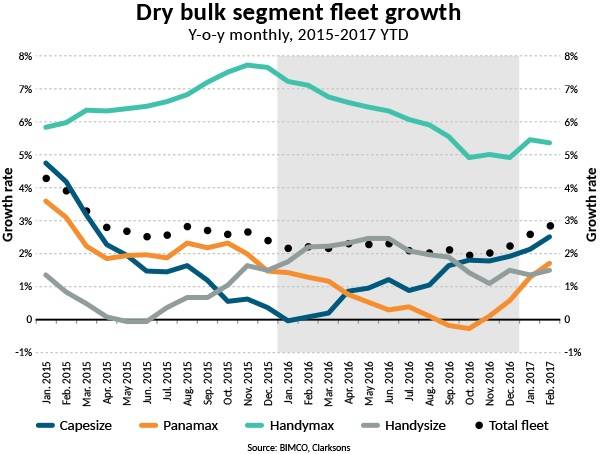Dry Bulk Fleet Grows as Supply Surges -BIMCO
As the dry bulk fleet grew by 2.6 percent year on year in January 2017 it exceeded 800 million DWT. This was due to dry bulk demolition being half of what is was in January 2016, while total dry bulk deliveries reached its highest level since January 2013.
In February 2017, fleet growth reached 2.8 percent. If the fleet growth remains above 2 percent, the dry bulk shipping industry cannot rely on global demand to cure the oversupply caused by this fundamental imbalance in the market. Therefore, industry actions, such as demolition, need to get back to the activity levels seen in the first half of 2016, where demolition figures balanced out close to 80 percent of the inflow of new dry bulk ships to the market.
Fleet growth expected to settle at 1.6 percent in 2017
BIMCO’s Chief Shipping Analyst Peter Sand commented, ”We expect to see an increase in the fleet across the board for dry bulk shipping in the first quarter of 2017, in part because this is always the quarter with the most deliveries of newbuilt ships.
The continued slowdown in scrapping and the lower level of demand in Q1, means that the supply side growth will exceed the growth in demand on a short-term basis and lead to lower dry bulk earnings in that given period.
Despite an uneasy start to 2017, fleet growth will start to stagnate and BIMCO expects to see a supply growth of 1.6 percent for the whole of 2017.
BIMCO expects 19 million DWT to be scrapped in 2017, which is lower than the previous two years of demolition activity - around 30 million DWT annually. With BIMCO’s “Road to Recovery” update due for publication mid-March, a revised projection of when the industry will turn profitable again, will be reviewed”.
Segmented demolition and delivery activity
The capesize segment breached the 2 percent fleet growth barrier in January 2017, after a constant increasing growth rate during 2016, since a 0 percent fleet growth rate in January and February 2016. This increasing capesize fleet growth is a result of capesize deliveries exceeding demolition activity. H1 2016 saw net capesize fleet growth of 0.3 million DWT and 5.6 million DWT in H2 2016. In the first two months of 2017, the capesize fleet has grown by 2.2 million DWT.
The panamax segment experienced a stall in fleet growth in the first three quarters of 2016, which led to a decrease in the growth rate. As H2 2016 delivered the lowest number of panamax bulkers in seven years, the demolition activity also stalled and the year on year fleet growth went from -0.3 percent in October 2016 to 1.7 percent in February 2017.
The handymax achieved the largest drop in fleet growth rates of all four segments, as it decreased from 7.2 percent in January 2016 to 4.9 percent in October 2016. However, it is still the highest fleet growth rate across all dry bulk segments, but shows an increasing willingness towards scrapping, as 4.3 million DWT of demolished handymax tonnage in 2016 was the second highest ever.
The handysize segment saw the lowest amount of DWT entering the market in eight years, while demolition activity also dropped to the lowest amount of DWT in six years. Thereby, the dry bulk shipping industry didn’t reap the full benefit of the reduced handysize deliveries, although handysize fleet growth decreased from 1.7 percent to 1.5 percent during 2016.
What to watch out for
As the capesize segment represents 40 percent of the total dry bulk fleet (measured in DWT), it represents the biggest share of the four ship types in DWT and is thereby also the main driver for total fleet growth. This is highlighted by total fleet growth stabilizing around 2 percent during 2016, as the declining growth rates from panamax, handymax and handysize were absorbed by a growing capesize fleet.
















